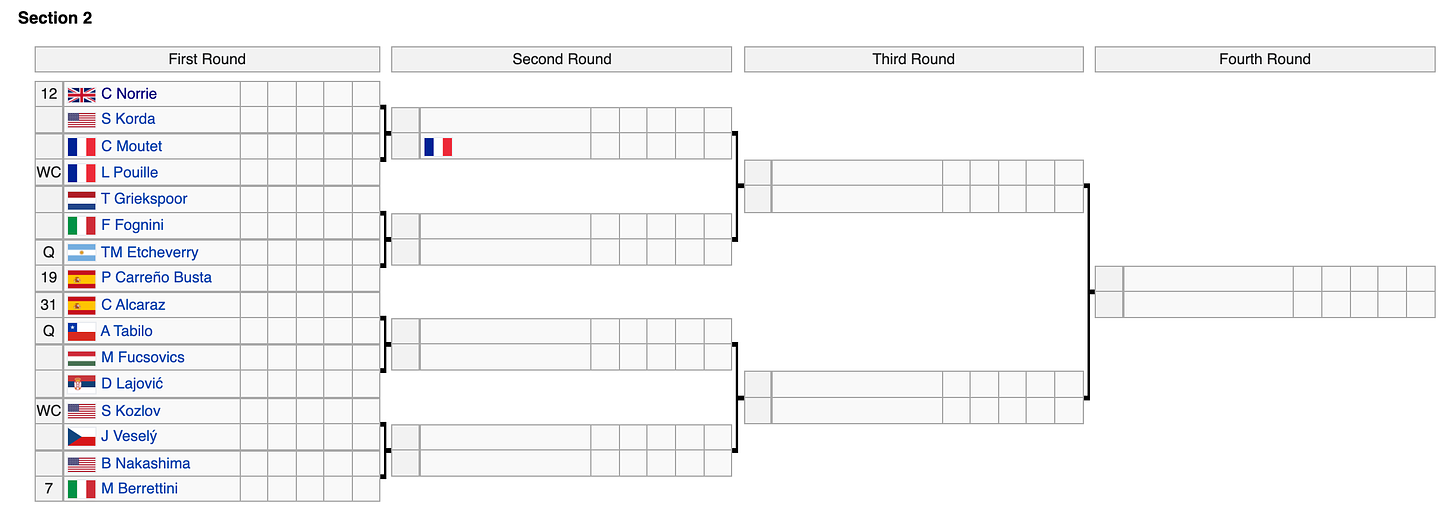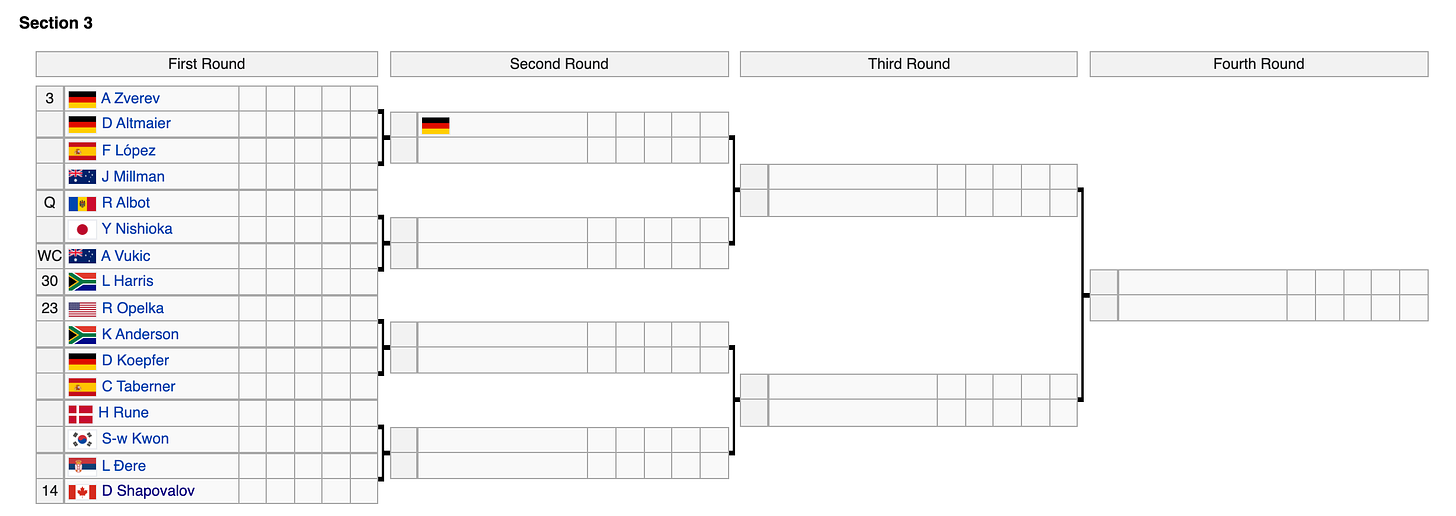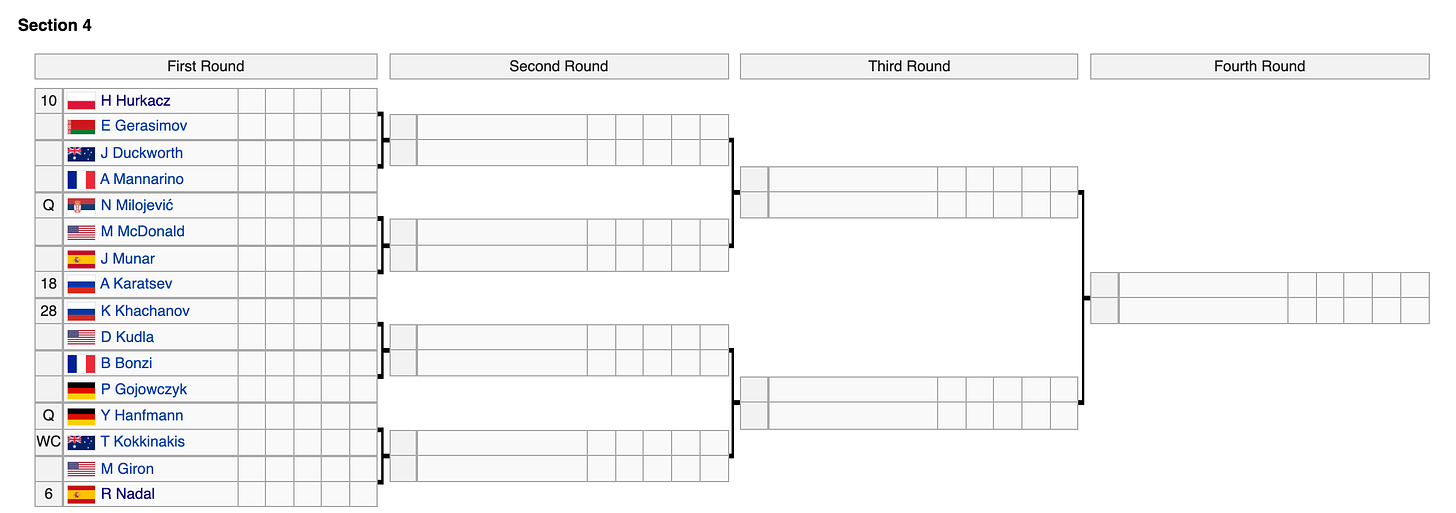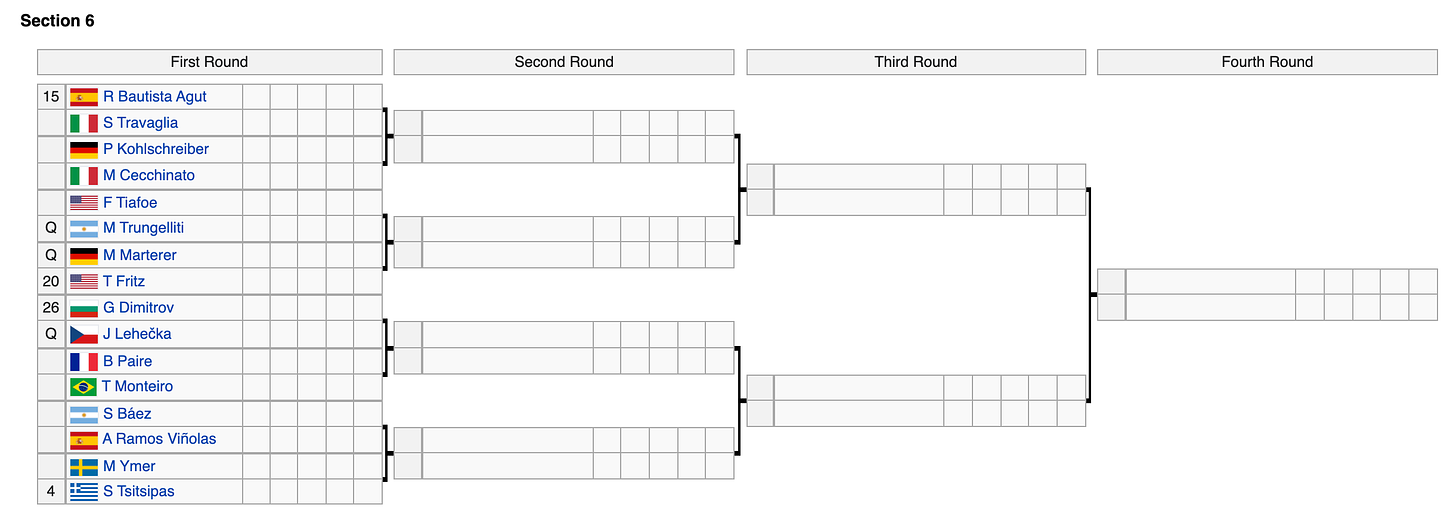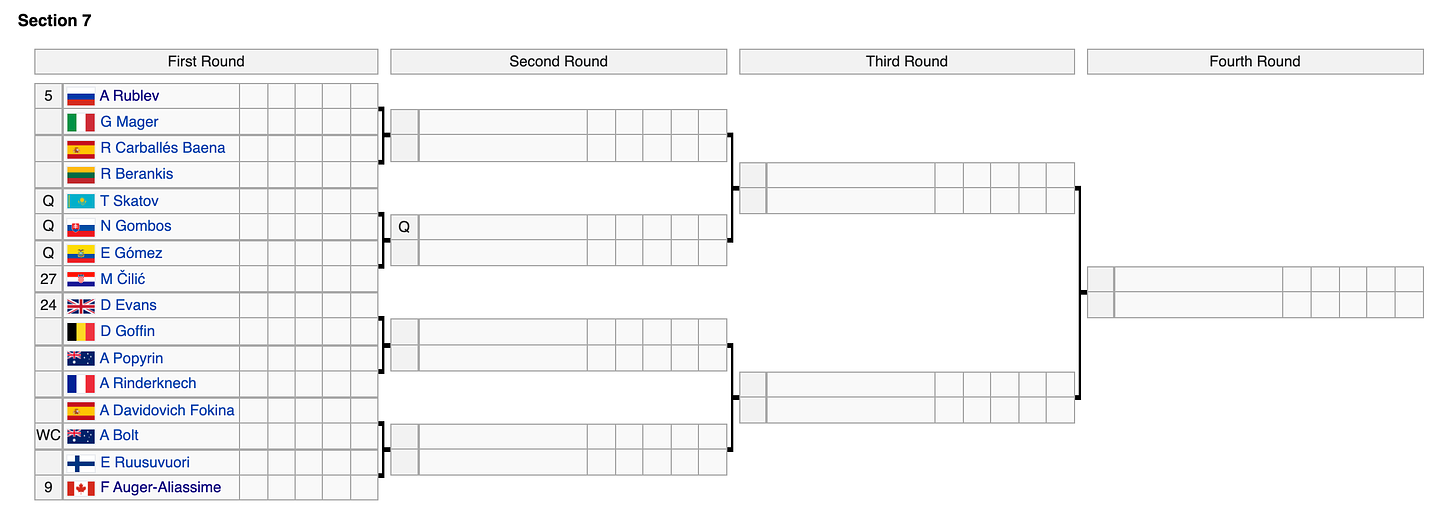See also: Women’s Bracket Preview
The 2022 Australian Open begins tonight, which kicks off the meat of this year’s tennis season. The Australian Open has long been my favorite grand slam tournament, with the right combination of a crowd that’s not too rowdy (like the US Open), but also not too stuffy (Wimbledon). It takes place at weird times of the night, which is perfect for night owls like me, is on the most naturally beautiful continent, and is a bright ray of warm sunshine in the middle of the depths of winter. What’s not to love? It’s also produced some of the best matches in men’s tennis history (2009, 2012, 2017 men’s finals), but the men who competed in many of those matches aren’t at their peak anymore.
Novak Djokovic is out of the tournament after being deported from Australia because he has not been vaccinated against COVID-19, which was a requirement to enter the country/play in this tournament. Roger Federer is also still recovering from surgery, leaving Rafa Nadal as the lone soldier still standing. But he is not as sharp on hard courts as he used to be, and at age 35, isn’t physically what he once was. All this leaves the 2022 Aussie Open wide, wide open.
With this as the premise, let’s preview this tournament. We’ll go section by section, making picks as we go, until we reach a champion. My hope is that casual fans will learn a lot more about the field, but you should absolutely ignore my picks, which are 100% guaranteed to be inaccurate.
Section One
Well this bracket looks different now that Novak Djovkoic is no longer in the draw due to the vaccine debacle. This column will not delve too deeply into that, but will simply say that the rules surrounding mandatory vaccination to compete in this tournament have been very clear for awhile and it was good to see that, for once, the powerful and famous did not get to skirt the rules that everyone else had to abide by. But without the nine-time champion in the field, suddenly this section is wide open.
The highest seed here is Cristian Garín of Chile, who has slowly been climbing the rankings. He made the fourth round at a couple slams last year, but he’s never been past the second round of a slam on hard court. Gael Monfils is one of the more fun good guys to watch play, having been around a loooooooong time, always bringing that adorable charisma. He certainly has the history of making it deep enough in slams to believe in him here. Just a matter of whether him being 35 now is too old, because Monfils isn’t what he used to be. Lorenzo Sonego has also improved over the last few years, but he’s a far better clay court player than a hard court player. Sam Querrey is lurking in this draw, but he’s declined considerably from his peak.
If there’s one dark horse in this section for me, it would be Tommy Paul. The 24-year-old American is at his highest career ranking (#41), having played some good tennis recently. He won the Stockholm Open in November, beating Denis Shapovalov in the final, and he made the fourth round of Indian Wells in October. Of course, his last time out at a major was a first round loss to an unseeded opponent in New York, so he could very easily lose first round. But, Paul has been playing well enough on hard courts lately to make me think he could make a run.
I’m going to pick Monfils here, but I have very little confidence in that selection.
Section Two
Very interesting bracket here, with a bunch of guys who really jumped onto the radar last year. Cam Norrie had a tremendous season, rising from #71 to #12 in 2021, largely due to winning Indian Wells. He still has yet to see a lot of success at the slams, but he’s become a fine player. Tricky wild card in Lucas Pouille though, a former top ten player who has made several deep runs at majors before. I’m on upset watch there if Pouille faces Norrie in the second round.
The middle of this section has a pair of Spanish seeds on opposite sides, Pablo Carreño Busta and Carlos Alcaraz. PCB has turned himself into a player, making the US Open semis a couple times, a good hard court player who could make some noise. Alcaraz is one of those guys who feels like something will have gone very wrong if, in seven years time, he hasn’t won a grand slam. The time is probably not now because the kid is only eighteen, but he’s 18 and he’s already seeded at a major. His run to the US Open quarters showed the freakish talent he has, and it’s hard not to think about another Spanish teen phenom from the past (we’ll let you come up with that name) when you look at Alcaraz.
All that said, this is Matteo Berrettini’s section to lose. Only four players in the world made at least three quarterfinal appearances at majors last year, and Berrettini was one of them, including making the finals at Wimbledon. He hits quite possibly the hardest forehand in tennis history (certainly that I’ve ever seen), an absolute rocket launcher from the baseline. I’ve been waiting for the rest of his game to catch up to the forehand (and serve), and I’m a tad unsure of his mental game. Berrettini met Novak in Paris, London, and New York last year, taking the first set in the latter two meetings, before losing three straight sets to be eliminated. His match in Paris was maybe the most frustrating, when Berrettini kept opting for a drop shot that was not working, even though the rest of his strokes were clicking. His raw stuff is good enough to win this tournament. Can he get over the mental hurdle? We’ll see. But at the very least, he’s good enough to get through this (rather light) section.
Section Three
This is the Sascha Zverev quarter. He was another one of the only four players to make three quarters last year, and one of only four to make two semi appearances. He’s been on the cusp for a long time, but I also have mental questions about him. More on that later I guess. Can anyone beat him in this section? Ehhh. I don’t see anyone. On the bottom half you have humongous Reilly Opelka and his giant serve. Opelka had a great 2021 but I just struggle to believe a 6’11” guy can win a five set match against an elite opponent from a stamina and conditioning standpoint. It’s not as easy to run for five straight hours when you’re a giraffe!
The only guy who I could see blocking Zverev from the quarters is Denis Shapovalov. The Canadian is a lot like Zverev and Berrettini in having the elite raw stuff but struggling from the mental side. In Shapovalov’s case, it’s the consistency. We saw his run at Wimbledon and it showcased his ability to beat almost anyone on any given day. He also didn’t move past the third round in any other slam or ATP 1000 tournament he played in 2021. The talent is there, and Shapovalov is electric when he’s on, a rare lefty with a one-handed backhand who can also play with pace. We just don’t see it enough. I’m hoping this is the year that Denis puts it all together but until he does, Zverev is the safe and logical pick here. It should be a good match if they meet in the fourth round, though.
Section Four
Here’s a fun fact: of the ten men’s players to make a major semifinal in 2021, seven are on this half of the draw [EDIT: actually it’s 6/9 now that Novak is out]. Three are in this section, Nadal, Karatsev, and Hurkacz. Let’s start with Hurkacz, the Polish player who had a great 2021, winning Miami and making the Semis at the Paris Masters and at Wimbledon. He’s suddenly gone from a player who you think “huh, not familiar with that guy” when you see his name, to a legitimate threat. Aslan Karatsev is also in the top half, by far the most random semifinalist at a major last season. He’s a decent player but that run was very out of character in terms of the scope of his career previously.
The bottom half is reserved for Rafa. Not much else needs to be said about Nadal. He’s one of the three best players in men’s history, and a legendary champion. He’s also 35 and doesn’t play many tournaments anymore, having played in just three of the six slams to be held since COVID began. Of course, he made at least the quarters in all three, including one title (2020 French Open), but he’s not the same player he once was away from clay. If he’s healthy, I like him to make it through to the fourth round at least, and I think he topples Hurkacz there, but his broader upside in this tournament is more unclear to me.
Section Five
Now this is a weird section. After the first four sections being loaded with guys I could see possibly winning it all, there’s no one here that I consider in that category. Casper Ruud has slowly become a player, but he hasn’t found the same level of success in five set events as three set ones. He’s also better on clay. Jannik Sinner will be one of the best players in the world in a few years, but I’m not sure if it’s go-time for him yet.
Who else is challenging here? The Corpse of Andy Murray makes it in this section, but he is not a serious challenger at this point in his career. I love Murray and he seems like a genuinely great guy, but he does not have the health or stamina to compete at a major anymore. Alex de Minaur and Nikoloz Basilashvili are names who normally bow out by the third round, and it could be even earlier for de Minaur, drawing hyped Italian teen Luca Musetti in the first round. Stevie Johnson and Andreas Seppi are both guys who used to be good and I guess could win a few matches. But any way you slice it, this section is producing a major quarterfinalist who we are not used to seeing. Just throwing a name out here as the guy to advance, and I’ve gotta pick one unseeded dude somewhere to make the quarters, so let’s tab Musetti.
Section Six
This is the Tsitsipas section. The Greek star had a great start to 2021, making the semis at this tournament (beating Nadal!), then was strong through the clay court season, leading up to his appearance in the French Open final. There he went up 2-0 in sets on Djokovic, and that’s when it all fell apart, as Novak stormed back to win it. Tsitsipas struggled on grass again, but then had a strong hard court season before flopping at the US Open in a tough five set loss to Alcaraz in the third round. Still, I saw enough of a championship mentality to believe that Tsitsipas is going to win a major at some point. He hasn’t beaten Novak in a slam yet, but he has beaten Federer and Nadal at this tournament and should have a lot of confidence in Melbourne.
Can anyone stop him from making the quarters? Grigor Dmitrov makes a semifinal run every three or so years, and it’s been since 2019 for the last one, so sure, I guess. He’s also 30 now. Taylor Fritz has never made it past the third round at a major. Roberto Bautista Agut is a solid player but not really the kind of guy you think is going to make a run. Honestly, the best hope of stopping Tsitsipas from winning this section is either Dmitrov snapping back to 2017 form, or Frances Tiafoe. Frances is a scrappy five set player who does well on hard court. Unpredictable, but honestly that’s what is more favorable in this draw than someone like RBA, who is predictably not a QF type player. I still think Tsitsipas will make it through with this decently easy hand dealt.
Section Seven
Interesting group of players here. Andrey Rublev and Felix Auger-Aliassime are the high seeds and both there’s a lot to like about both players. Rublev is one of the more consistent guys on the tour, having quartered at three slams, and he made at least the semis at three different ATP 1000 tournaments in 2021 (Miami, Monte Carlo, and Cincy). I’ve yet to see him flash the level of play that makes me think he can win a major, but in terms of a decently safe bet to win three or four matches, Rublev is probably the best selection out there beyond the big four/five/six(?) (Novak, Rafa, Medvendev, Tsitsipas, Zverev, Berrettini).
On the flip side, FAA is a player who I think has shown a higher level of play than Rublev, yet less consistency. I like the other Canadian (Shapovalov) more when they’re both at the top of their game, but FAA improved dramatically last season. He was the only player outside of those big six names I mentioned above who made the quarters at two different slams last season, so that speaks for something. Auger-Aliassime’s performance in the smaller tournaments and overall yearly winning percentage (~60%) isn’t as high as you’d like to see for a player seeded in the top ten, but when his game is on, the lanky Quebecer is a tough out. I think his draw sets up well to make the fourth round at least.
The last name here who merits discussion is ole Marin Čilić, grand slam champion and three-time major finalist. Now 33, Čilić isn’t what he once was, but you can never count out his big serve, and more importantly, 15 years of experience playing in five set, high pressure matches. I like the younger guys physically in a hypothetical matchup with Čilić, and I’ll take FAA as my name to make it through.
Section Eight
Is any player here beating Daniil Medvedev? Probably not. The big Russian is the best non-Djokovic player in the world by a considerable margin in my opinion, especially on hard courts. His last three hard court slams saw him make the semis every time, the finals twice, and then obviously he won the US Open back in September, dropping just one set along the way (spanking Novak in the final). Medvedev is one of the strangest players in the game, a big man who plays a shorter player’s game. His serve is big, given his height, but he doesn’t have super hard groundstrokes like most modern men’s players have, and his approach is generally very defensive. Yet, he’s got a high tennis IQ and most pivotally, he’s got a champion’s mentality that none of Berrettini, Shapovalov, or Zverev have yet to find. Sometimes, that’s all that matters. Medvedev made at least the the fourth round of every slam last season, went 20-3 in major matches, won at an 83% clip for the year, and can ascend to world #1 if he wins this event. Tough combination to beat.
Based on the list of names here, I don’t see anyone who is stopping him from reaching the quarters in a five setter. Diego Schwartzmann is my spirit animal, the pint-sized Argentinian, who is at a natural disadvantage given his height, yet has a lot of heart. It just feels like his size puts a cap on how deep he can go in today’s game. John Isner is a player who no one has ever said was too short. Like Opelka, the dude is just too tall to win seven straight five set matches, and we have a decade’s worth of evidence to support that.
Beyond that, you have crafty veteran Richard Gasquet and young Frenchman Ugo Humbert, but neither of those guys are beating Medvedev. Honestly, if anyone could do it, it might be like Tiafoe in the Tsitsipas section, someone random and highly unpredictable… in that case, let me introduce you to Nick Kyrgios. A Kyrgios-Medvedev second round match would be worth the price of admission, let me tell you that.
Kyrgios will be remembered as one of the most classic examples in sports of having all the tools, but not the mental component to put it all together. His raw skill is top ten level, but he gets in his own way because he’s a nutjob. Maybe if it all went right, with the home crowd behind him, I could see it happening, but it’s hard to envision it when it’s Medvedev we’re talking about. A different top seed, maybe, but Medvedev loves to be the villain and is everything Kyrgios wishes he could be: a straitlaced, conventional, calculating assassin. The epitome of rational vs. irrational. It would be fun to watch, but Medvedev would win.
Quarters
Based on my picks I have:
(17) Monfils vs. (7) Berrettini
(3) Zverev vs. (6) Nadal
Musetti vs. (4) Tsitsipas
(9) Auger-Aliassime vs. (2) Medvedev
Probably just a pinch too chalky, but this isn’t far off from how the men’s game now is these days. In the top half, I’ll take Berrettini over Monfils, while that Zverev vs. Nadal matchup is vexing. Rafa is 6-3 all-time, but they haven’t met at a major since Australia five years ago, which is a long time when one has since aged into his prime and the other has aged out of it. Zverev has won 3 of the last 4 meetings and the two are an even 2-2 on hard courts. Though I still have questions about Sascha’s mental stamina, I think his physical stamina gets him by the 35-year-old Rafa in a tough five set match.
On the bottom half, Tsitsipas over Musetti and Medvedev over FAA. I’d hope to see Auger-Aliassime get closer to Medvedev than they were in New York in September, but that was an easy enough win for the Russian. FAA would have to play a ton better to win this time, and I just don’t see it (yet).
This leaves us with:
(7) Berrettini vs. (3) Zverev
(4) Tsitsipas vs. (2) Medvedev
This would be a very fun semifinals. Zverev owns the series over Berrettini 4-1 and though I picked Berrettini to make it this far because of a rather easy draw, he hasn’t actually been playing that well recently. Whereas, Zverev won the ATP Tour Finals back in November. Sascha makes it to his second major final.
Tsitsipas–Medvedev is slowly becoming one of the most fun rivalries in tennis. Their parents are friends and were once hitting partners, but now actively dislike each other after a 2018 match gone wrong. Tsitsipas has since described Medvedev’s game as “boring” and “one-dimensional”, trash talking that this sport has been missing. Medvedev has dominated the rivalry 6-2, but Tsitsipas notched a win in their most recent meeting at the French Open. Tsitsipas has the edge when they’re on clay, but Medvedev is clearly better on hard courts. Daniil also has the upper hand mentally, even if Tsitsipas is becoming mentally tougher. I am going to take Medvedev in a long one, but I would probably be cheering for Tsitsipas.
Champion?
Well this sets us up for Zverev vs. Medvedev. Sascha returns to a major final for the first time since his heartbreaking loss to Thiem at the 2020 US Open, while Medvedev would be in his fourth major final. The two are 6-6 against each other, but the Russian owns 5 of the last 6. He’s also the better player right now, the though player mentally, and again, this is a hard court event. All of this sets up for a Medvedev victory. But even if I think this is how it plays out, it would be Zverev’s chance to prove me wrong. I’m hoping that both him and Tsitsipas do it.




